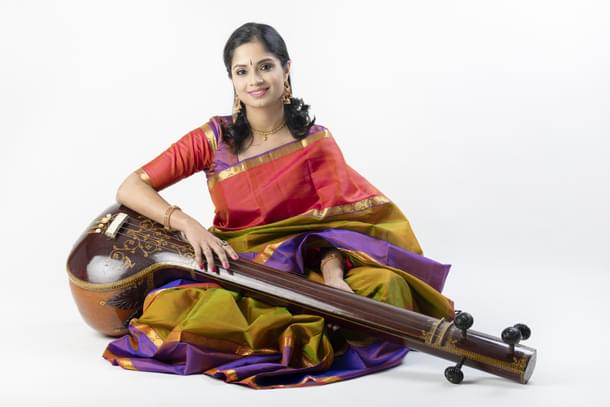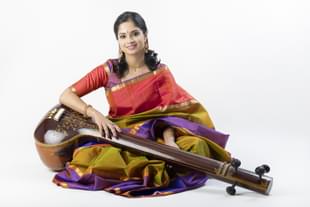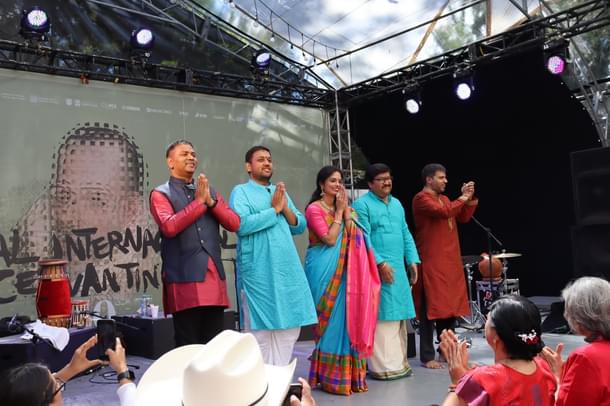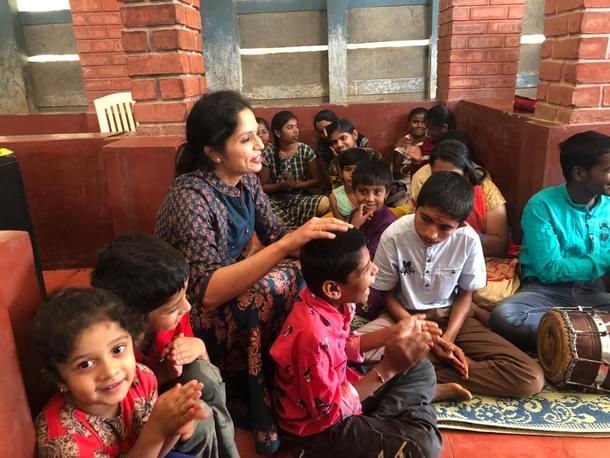Culture
Manasi Prasad: How This Carnatic Vocalist Negotiates Between Cerebral Compositions And Emotional Expressions
Ranjani Govind
Nov 19, 2022, 08:32 PM | Updated 08:39 PM IST
Save & read from anywhere!
Bookmark stories for easy access on any device or the Swarajya app.


Carnatic exponent Manasi Prasad, well-known for her multi-tasking skills, received a standing ovation on Thursday after her lec-dem on ‘Multiple aspects of Pallavi presentation’ at the Karnataka Ganakala Parishat’s annual music conference in Bengaluru.
She has also been a practitioner of the rare facet of the classical genre, Avadhana Pallavi (singing of Pallavi simultaneously handling two different talas in two hands). The Bangalorean, who started off early on stage, was in Chennai and Hyderabad post marriage where she received the Semmangudi pathantara from V. Subramanyam and a mentorship in aesthetics from Dr. Sriram Parasuram.
She also learnt Hindustani flourishes from Swati Phadke, a disciple of Vidushi Prabha Atre.
Manasi back home was involved in a noteworthy project that saw her helm the formation of the Indian Music Experience (IME), India’s first interactive music museum, as its project director.
Blessed to have performed in prestigious venues as a young artiste - from Africa to South America to the US and Europe - she owes her creative instincts to the primary training received from her guru Vidwan RK Padmanabha, who is amongst the few who can boast of an astonishing range of recordings.
While every exposure broadened her perspective, “RKP will remain a permanent vast guide,” says Manasi who will receive the ‘Ganakalashree’ Award from Karnataka Ganakala Parishat this weekend. “Many legendary and star artistes of Karnataka have received this award, so I feel a sense of responsibility to work hard to prove myself worthy of this honour,” she says.
The MBA holder from IIM Bangalore has conceptualised new productions in classical genres, and has collaborated with leading dancers as a vocalist and composer too. Manasi has received the Yova Puraskar from Sangeet Natak Akademi, various Fellowships from the TED, Melton Foundation, and the Aspen Global Leaders Network.
The ‘Ganakalashree’ Awardee , on the sidelines of her Parishat concert, spoke in an exclusive to Swarajya on various facets of her musical life….
You are always extolled for your ‘Avadhana Pallavi’ in your concerts!
My guru RK Padmanabha is known to throw challenges that help improve our repertoire. During our travel to Mysore about two decades ago, he asked me if I could sing a ‘pallavi’ with Adi tala in one hand and Rupaka in the other!
When I was able to negotiate that, he decided that I learn the nitty-gritty of ‘Avadhana Pallavi’ from Padma Gurudatt, an expert in the form.
Gradually he guided me into practicing the ‘rare facet’ of Carnatic music that could be a cerebral-add-on to concerts and lecture demonstrations in Pallavi.
Your lec-dem on ‘Pallavi’ was an eye-opener at the Parishat proceedings…
The raga-tana-pallavi is one of the most interesting aspects in the Carnatic repertoire. It provides infinite scope for creativity, of course within the bounds of the raga, tala and conventions of practice and tradition.
It tests the skill of a musician, and one can choose to challenge oneself at various levels, both in the construction the rendition of Pallavi.
While Pallavi singing has been prevalent for Centuries now, it is interesting to know the journey of pallavi presentations and how it continues to provide endless room for novelty.
There are innovations in the raga aspects (use of Hindustani ragas, multiple ragas, grahabheda etc.), in the tala (the 35 tala system, 108 tala system, mela talas, multiple nadais etc) and sahitya (raga mudra, composing for the occasion, svarakshara etc).
‘Avadhana Pallavi’ - in addition to all the above aspects of raga, tala, sahitya and manodharma - requires a deep sense of multitasking and also mindfulness of being completely 'in the moment' and focused, as it involves different talas in right and left hand.
Can we trace your music-learning? How far have your gurus been able to shape the facets that you are known for today?
I have a mad love for learning anything new in melody! My memories go back to being on my mother Tara Prasad’s lap as a four year old, as she taught music to children at home.
After returning to India from Kuwait, due to the Gulf War, I started learning from Jahnavi Jayaprakash, and then her nephew Dr. K Varadarangan. Jahnavi's approach to manodharma was admirable, and I cannot forget concepts as Graha Bheda that were lucidly illustrated by Varadarangan.
Needless to say, the guidance I later received from RK Padmanabha has been profound in terms of repertoire - countless compositions, insistence on long notes, approach to singing raga and sarvalaghu svara.
RKP constantly urged me to contribute to music beyond performance. In fact I still preserve a letter from him during my teens, and his advice said my role model should be someone like Rukmini Devi Arundale who founded Kalakshetra.
It comes as a surprise years later now that I did indeed lead the set up of the Indian Music Experience Museum, the first interactive music museum in India!
After years of absorbing I have begun to assimilate all these factors into my own unique expression. I have evolved a core belief that all music is interconnected. While there are particular aspects to each genre, they are not watertight as each stream flows into the other.
Your journey reflects your belief that 'music has to be relevant to the times'
Yes, while I am very respectful of tradition, I completely believe that any art form has to connect for it to be relevant to changing times. After all, our great classical forms are all living traditions - and like living beings they grow, adapt, change and evolve.
My broader appreciation I think started with the fact that as a child I loved all forms of creative expression. I am a trained Bharatanatya dancer and I seriously pursued dance for many years.
As a child I read a lot of books and poetry, wrote a decent bit, listened to all kinds of music. For me, art is an expression of emotion, and there has to be something there that makes a member in the audience connect - in some cases it is just the sound, or the story behind the song, sometimes it is the lyric or the context, other times it may be an instrument!
I also believe music is a spectrum between pure tradition on one end and unrestricted innovation on the other. Each of us needs to find where we fit.
I ask myself - what do I believe, is core to classical music? The answer is: sruti, raga, tala, bhava, sahitya. The rest of it - presentation format, theme, structure etc is something that changes with time.
It is this push-and-pull, between deep rooted tradition and the impetus for change that makes classical music alive and exciting as a performer, presenter, student and audience.
Your broader comprehension of melody and your interest in academics helped you in gathering ideas for formulating the music interactive museum, IME?
Definitely the variety of experiences I have had helped me form a world view that has reflected in the visioning for the set up of the IME Museum.
First off, the founder of the museum is the farsighted, M.R. Jaishankar, the Chairperson of the Brigade Group, whose dream it was to have a music museum on the lines of the Experience Music Project in Seattle USA.
My work was in taking that one line idea of "music museum" and building the dream and executing it with support from multiple people, including noted musician and vainika Dr. Suma Sudhindra, exhibit designers Gallagher and Associates (U.S.) and many others. This project made use of all my learnings accumulated.
As for my work later at IME, it was a culmination of experiences and music travel.
In my interactions with engineering students, IIM, and work, I realised that people know very little about the ocean of diversity that is Indian music. Everyone has their own stereotypes of what it is.
So it was important that our museum reflects this idea of diversity. So in order to appreciate any music better, knowing the story, the inspiration, the deeper meaning helps one develop the ‘connect.’
Also, I believe that people disengage when they are bored, so the music experience brought over at IME was designed to be fun and engaging. These values have hopefully got reflected at the IME, which is visited by thousands every week.
At IME we started ‘exchange programs’ where we host artists in residence from various parts of the world learn and collaborate with Indian music and musicians.
For many years now I have been doing workshops for international groups at my alma mater IIM Bangalore and also for different Corporates. These workshops explore how we can Create, Communicate and Collaborate, by taking ideas from Indian music. These interactions have helped me understand what audiences resonate with.
In your international tours you address melody for totally new audiences, your recent tour being a case in point? How challenging is it being a vocalist in foreign platforms where lyrics are involved?
I enjoy sharing music with international audiences – with lesser preconceived notions about what Indian music is, they respond to what they hear.
I just returned from an ICCR concert tour of Mexico, where we performed at 12 cities across Mexico, including the prestigious Cervantino International Festival.
The concerts we presented focused on Carnatic music with various Indian flavours including a bhajan and folk song. We even combined a famous Mexican song with an old Bollywood song, and brought in some Konnakkol too.
Surprisingly I didn’t feel a language barrier - the sound of Indian music, its rhythm, raga structures and emotive content is rich enough to move audiences anywhere in the world.







